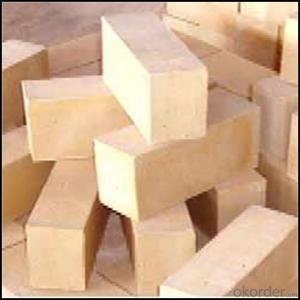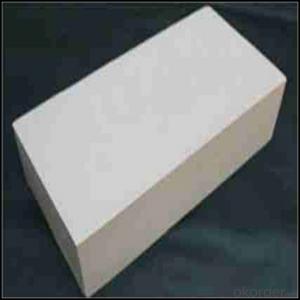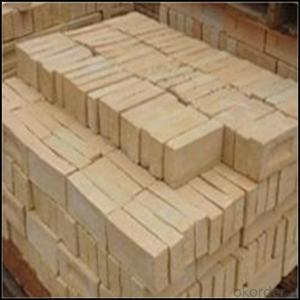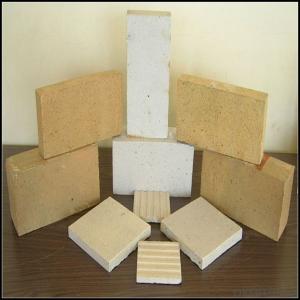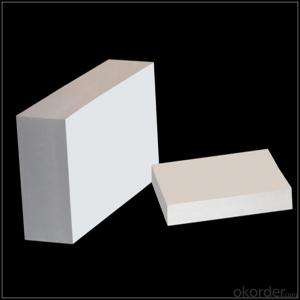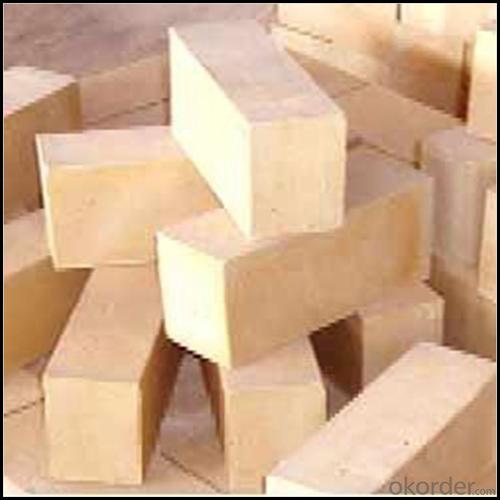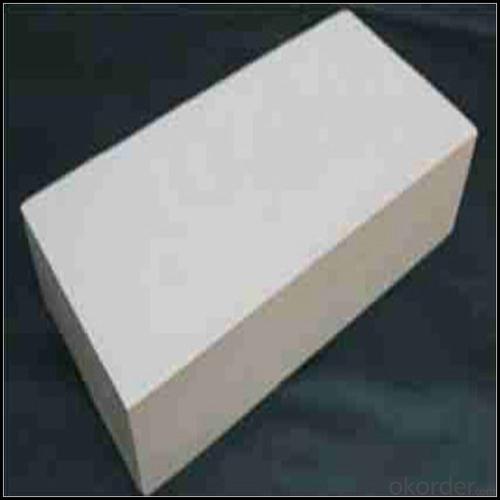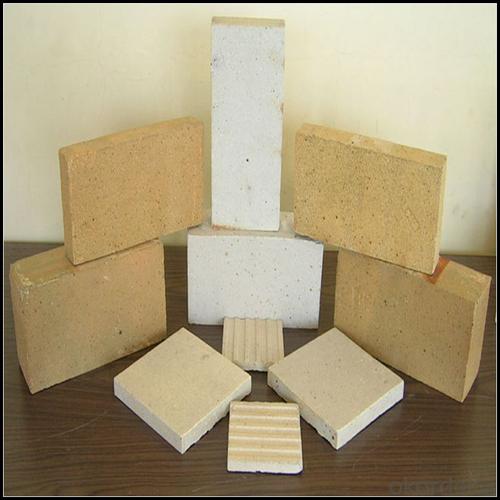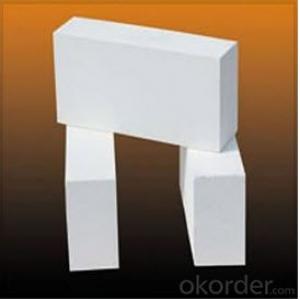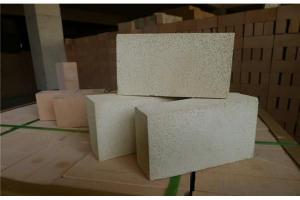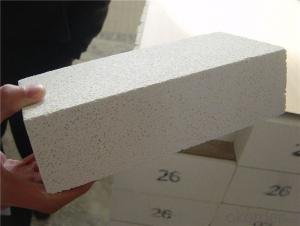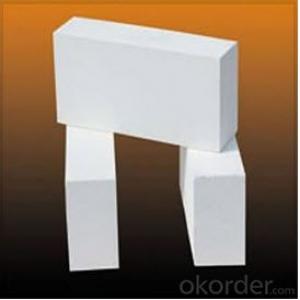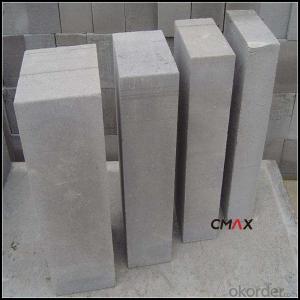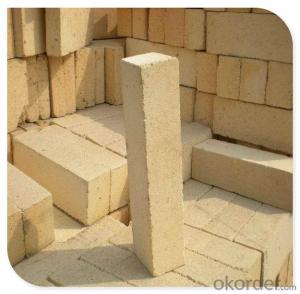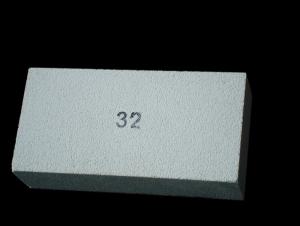Insulating Fire Brick - Refractory Brick for Furnace, Fire Brick Prices, Clay Brick
- Loading Port:
- China main port
- Payment Terms:
- TT OR LC
- Min Order Qty:
- 0.01
- Supply Capability:
- 2200 m.t/month
OKorder Service Pledge
OKorder Financial Service
You Might Also Like
Acid Resistant Brick
CMAX firebricks are classified under temperature between 1300℃ to 1700℃, manufactured from high purity alumina clay by mixing, press-forming, drying, sintering and machining. Bricks contain carefully-graded organic fillers which are burned out during sintering to give a uniform controllable pore structure. This technique makes product feature low thermal conductivity and excellent heat insulation
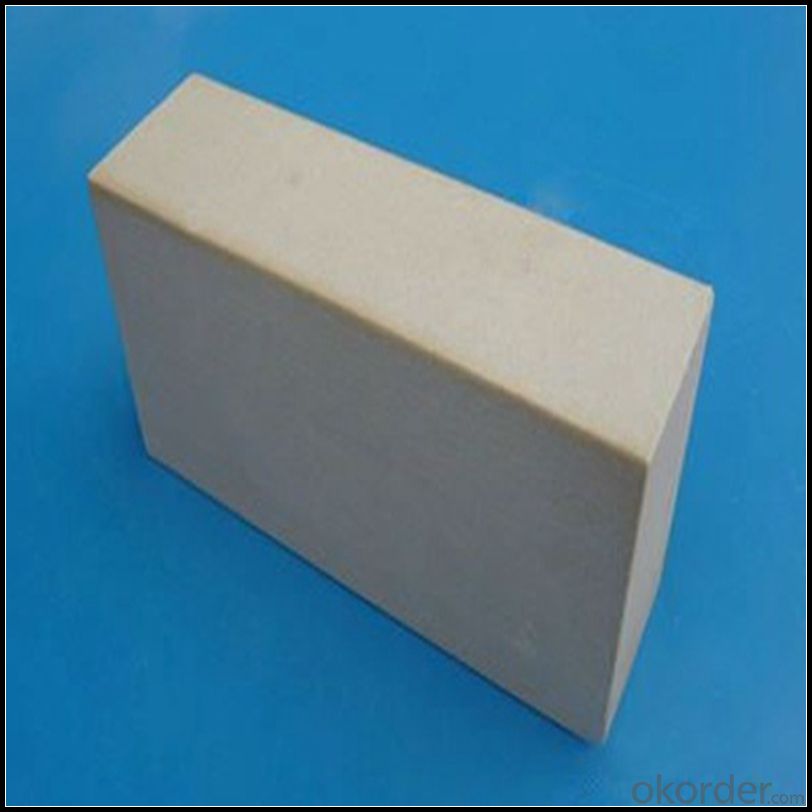
Features
Light weight and low thermal conductivity allows thinner furnace walls
Maintain stable structural strength throughout ambient to maximum service temperature
Low heat storage results in rapid cooling and heating operation
Low iron and impurities to enhance reducing atmosphere
High thermal shock resistance in preventing spalling
Non standard sizes and shapes are available upon request
Application
1. Building materials for blast furnace
2. Building materials for hot-blast stove
3. Building materials for coke oven
4. Building materials for steel making furnace
5. For construction material in steel industry
6. For ladle
Data Sheet
Classification Temperature (℉/℃) | 3000/1650 |
Bulk Density (g/cm3 ) | ≤1.0 |
Thermal Conductivity | |
800℃, W/m.K | ≤0.39 |
1000℃, W/m.K | ≤0.43 |
1200℃, W/m.K | ≤0.48 |
Reheating Linear Change (%) | 1550℃×12h |
≤0.9 | |
Chemical Composition (%) | |
Al2O3 | ≥75 |
Fe2O3 | ≤0.5 |
Packaging & Shipping
Packaging Details:Be packed in fumigated wooden pallets
Delivery Detail: 30 days after order

Our Services
Optimum solution and product supply of refractories for high temperature industries, such as iron steel, non-ferrous, petrochemical and building materials.
Engineering design, contract and consult for refractories, and civil architecture design.
Research, development, manufacture and sale of superhard materials.
R&D, manufacture and sale of special packing materials for export.
Inspection, supervision and arbitration of refractories.
Consultation and services in refractories information.
Training and cultivation of high-level talents in refractories profession
Sales Network

Company Information
CNBM (China National Building Material) Group is the largest comprehensive building materials group in China that in integrate scientific research, manufacturing and logistics into one entity. The largest building materials and equipment specialists in China. Upon State Council approval, today CNBM owned more than 300 subordinate manufacturing factories and servicing companies. There are 6 fully owned public listed companies and 11 partially owned with substantial shares public listed companies. In many of these fields, CNBM is playing the leading role in the building industry in the country.
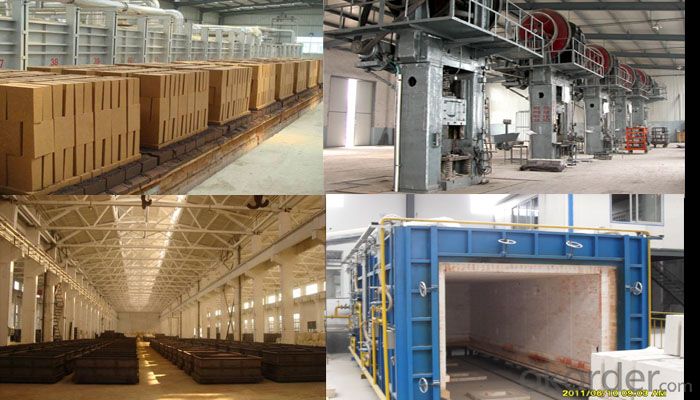
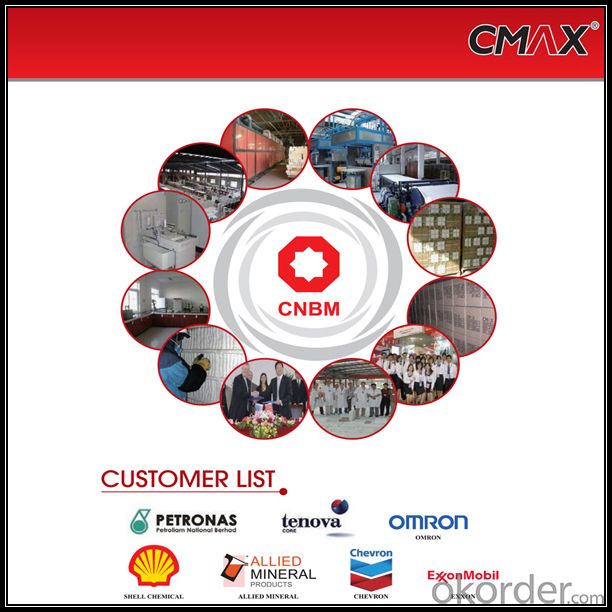
FAQ
1. Which products do you have?
We have all kinds of refractory brick, castable, mortar, cement, ceramic fiber products, etc.
Or you could browse our products to choose what you need.
2. Can you give me a brief introduction of the application of your products?
We are mainly specializing in the refractory materials in iron and steel, cement, glass, ceramics, petrochemical, electric power Industry, etc.
3. If I need your offer, what information do you need?
In order to choose suitable products, it will be appreciated to provide us the information, such us specification, technical data, order quantity, products application etc. If any question, please contact us freely.
- Q: Can insulating fire bricks be used as insulation in walls and roofs?
- Yes, insulating fire bricks can be used as insulation in walls and roofs. Insulating fire bricks are made from lightweight materials that have excellent thermal insulation properties. They have low thermal conductivity, which means they can effectively reduce heat transfer through walls and roofs. This makes them a suitable choice for insulating buildings and improving energy efficiency. Additionally, insulating fire bricks are durable and fire-resistant, making them a safe option for insulation. However, it is important to note that insulating fire bricks are typically used in high-temperature applications such as furnaces and kilns, so they may not be the most cost-effective or practical choice for all wall and roof insulation needs. Other insulation materials designed specifically for building applications may be more suitable in terms of cost, ease of installation, and overall performance.
- Q: Can insulating fire bricks be used in metal smelting furnaces?
- Yes, insulating fire bricks can be used in metal smelting furnaces. Insulating fire bricks are designed to have low thermal conductivity, which means they can effectively retain heat and prevent heat loss from the furnace. This makes them ideal for use in metal smelting furnaces, where high temperatures need to be maintained for extended periods of time. Additionally, insulating fire bricks are resistant to thermal shock and can withstand the harsh conditions and rapid temperature changes that occur during metal smelting processes. They are also lightweight, making them easier to handle and install in the furnace. Overall, insulating fire bricks are a suitable choice for use in metal smelting furnaces to improve energy efficiency and increase the lifespan of the furnace.
- Q: Can insulating fire bricks be used in the construction of tundishes?
- Yes, insulating fire bricks can be used in the construction of tundishes. Tundishes are commonly used in the steel industry to distribute molten metal, and insulating fire bricks are ideal for this purpose as they have excellent thermal insulation properties and can withstand high temperatures.
- Q: Can insulating fire bricks be used for insulation in power plants?
- Yes, insulating fire bricks can be used for insulation in power plants. Insulating fire bricks are designed to have excellent thermal insulation properties, which make them suitable for high-temperature applications. They can withstand extreme temperatures and provide effective insulation to prevent heat loss and increase energy efficiency in power plant operations. The insulating fire bricks are often used in various areas of power plants, such as furnaces, boilers, kilns, and chimneys. They can be used to line the walls, floors, and roofs of these structures to reduce heat transfer and maintain the desired temperatures inside the equipment. In power plants, insulating fire bricks help to minimize heat loss, improve combustion efficiency, and reduce thermal stress on the equipment. By providing a barrier against heat transfer, they help in conserving energy and reducing operational costs. Additionally, the insulation properties of these bricks also contribute to a safer working environment for power plant personnel. It's worth noting that while insulating fire bricks are suitable for insulation in power plants, they should be selected carefully based on the specific requirements and conditions of the power plant. Factors such as the operating temperature, chemical exposure, and mechanical stress should be considered to ensure the bricks can withstand the harsh conditions and provide long-lasting insulation performance.
- Q: Can insulating fire bricks be used in wastewater treatment plants?
- Yes, insulating fire bricks can be used in wastewater treatment plants. They are often used in the construction of furnaces, kilns, and other high-temperature applications in these plants to provide thermal insulation and retain heat efficiently.
- Q: Can insulating fire bricks be used in the construction of lime production ovens?
- Indeed, the utilization of insulating fire bricks is feasible when constructing lime production ovens. These fire bricks are engineered with the explicit purpose of enduring elevated temperatures and offering optimal thermal insulation. The fabrication of lime necessitates materials capable of enduring the intense heat generated while converting limestone into lime. Insulating fire bricks possess not only exceptional heat resistance, but they also exhibit minimal thermal conductivity, thus reducing heat dissipation and enhancing energy efficiency throughout the lime production procedure. Moreover, these fire bricks are lightweight and effortlessly manageable, rendering them suitable for the construction of lime production ovens.
- Q: Can insulating fire bricks be used for insulation in gas furnaces?
- Indeed, insulation in gas furnaces can be achieved by utilizing insulating fire bricks. These bricks are crafted from lightweight materials like clay and other minerals, boasting remarkable insulation capabilities. Specifically engineered to endure extreme temperatures, they are extensively employed in industrial settings, notably gas furnaces. By reducing heat loss, enhancing energy efficiency, and sustaining elevated temperatures within the furnace, these bricks play a crucial role. Furthermore, they exhibit resistance to thermal shock and can withstand the corrosive impact of gases and chemicals commonly found in gas furnaces. Hence, insulating fire bricks serve as a suitable option for insulating gas furnaces.
- Q: Can insulating fire bricks be used in blast furnaces?
- Insulating fire bricks have the capability to be utilized in blast furnaces. These bricks are specifically designed to endure high temperatures and provide exceptional thermal insulation. Blast furnaces operate under extreme temperatures, typically reaching around 1500°C (2732°F), and thus require materials that can withstand such harsh conditions. Insulating fire bricks are constructed from lightweight substances like ceramic fibers, which possess low thermal conductivity and effectively retain heat. This makes them highly suitable for lining the walls and roofs of blast furnaces as they aid in energy conservation, minimize heat loss, and enhance overall furnace efficiency. Moreover, the use of insulating fire bricks in blast furnaces also serves to safeguard the structural integrity of the furnace by reducing thermal stress and preventing excessive heat transfer to the surrounding environment. Ultimately, the incorporation of insulating fire bricks in blast furnaces contributes to enhanced performance, energy preservation, and prolonged furnace lifespan.
- Q: Can insulating fire bricks be used in the construction of steam boilers?
- Yes, insulating fire bricks can be used in the construction of steam boilers. Insulating fire bricks are made from lightweight refractory materials that have excellent thermal insulation properties. They are designed to withstand high temperatures and provide insulation in industries where heat retention is crucial, such as steam boiler construction. Insulating fire bricks have low thermal conductivity, which means they can effectively minimize heat loss and improve energy efficiency in steam boilers. By using these bricks in the construction of steam boilers, the overall heat transfer efficiency can be increased, resulting in reduced fuel consumption and lower operating costs. Furthermore, insulating fire bricks have good resistance to thermal shock, meaning they can withstand rapid changes in temperature without cracking or breaking. This is important in steam boiler applications, where the temperature can fluctuate significantly during operation. In summary, insulating fire bricks are a suitable choice for steam boiler construction due to their excellent thermal insulation properties, low thermal conductivity, and resistance to thermal shock. They can help improve energy efficiency, reduce fuel consumption, and ensure the longevity of the boiler.
- Q: Can insulating fire bricks be used for insulation in chemical storage tanks?
- Yes, insulating fire bricks can be used for insulation in chemical storage tanks. Insulating fire bricks are specifically designed to provide high levels of thermal insulation, making them suitable for various industrial applications, including chemical storage tanks. These bricks have excellent insulating properties due to their low thermal conductivity, which helps to minimize heat transfer and maintain a stable temperature inside the tank. Additionally, insulating fire bricks are resistant to high temperatures and can withstand the corrosive nature of many chemicals, making them a suitable choice for insulating chemical storage tanks.
Send your message to us
Insulating Fire Brick - Refractory Brick for Furnace, Fire Brick Prices, Clay Brick
- Loading Port:
- China main port
- Payment Terms:
- TT OR LC
- Min Order Qty:
- 0.01
- Supply Capability:
- 2200 m.t/month
OKorder Service Pledge
OKorder Financial Service
Similar products
Hot products
Hot Searches
Related keywords

